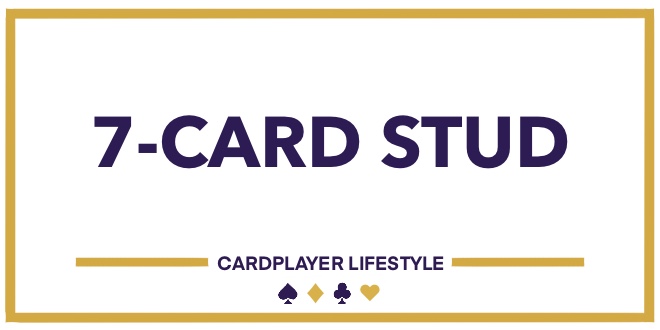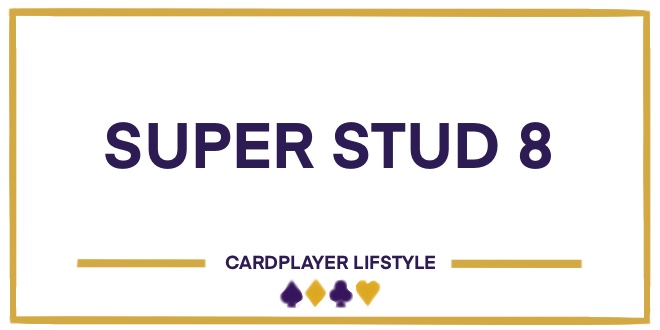If, like me, you remember learning how to play poker as a kid, you know that before there was Hold ‘em, there was Stud.
It was the most popular version of poker before Hold ‘em began to grow in the 1980s. Now, while not as prominent as they once were, Stud variants remain an integral part of mixed games. In this section of our Mixed Games Poker Guide, we’ll be covering the classic variants of 7-Card Stud, Razz and 7-Card Stud 8 or Better, as well as some spicy variations that have evolved in the wider mixed games collective like 7-Card Stud high/low with No Qualifier, Super Stud 8 or Better, and Razzdugi.

Also, be sure to check out our other Mixed Games Poker Guide articles on Flop Games and Draw Games.
Looking to play mixed game poker? Look no further than our recurring Mixed Game Festival live event series! Plus, you can run your very own mixed game at home with a set of mixed game plaques.
THE CLASSICS
Three of the staple games in H.O.R.S.E. or an 8-game mix are 7-Card Stud, 7-Card Stud 8 or Better, and Razz. Generally speaking, in these (as well as other stud games), card memory is key. In other words, there’s a ton of information available to you in the form of your opponents’ face-up cards. As they fold, it’s critical you remember what those cards were as they dramatically change the math regarding the likelihood of you and your remaining opponents hitting hands. Knowing with certainty, for example, that there’s just one 6 left in the deck will directly influence whether you should bet, raise, check, call, or fold on specific streets.
Shockingly, many new players don’t pay enough attention to this critical part of the game. This is even worse than a basic level of thinking in Hold ‘em, where players don’t think beyond the strength of their holding. With so much information provided throughout a Stud hand, it makes the puzzles of a hand infinitely easier to solve. The fact of the matter is that you’ll almost always have pot odds to make the call, but that’s not always the correct play.

7-Card Stud
As opposed to Texas Hold ‘em, where all players play two hole cards with a board of five community cards, in a hand of Stud, players will begin with two down cards, but then be dealt their own boards face-up as the hand progresses.
The action begins with all players posting a designated ante, followed by the deal of “3rd street”. Specifically, players are given three cards, two face-down (as in hold ‘em), and one card face-up known as the “door card”.
From there, the player with the lowest door card must post a forced bet called the “bring-in”, which will be roughly double the value of the ante. In a $20/$40 cash game for example, the ante could be $2 or $3 with the bring-in being $5.
Action then proceeds to the player to the left of the bring-in, who has the option to call the bring-in bet, “complete” to the lower limit in the game (in that $20/$40 cash game, they can “complete” to $20), raise (to $40) or fold. Play continues clockwise around the table with players able to call the previous bet, raise, or fold, until it comes back around to the bring-in for the same options, and so on until the round of betting is completed. In a standard stud game, up to four raises, or $80 in this case, would be allowed. Stud games can be played pot-limit or no-limit, but generally is not.
At this point the dealer gives each player another card face-up (4th street), with the highest open hand now given the first opportunity to act, and action again continuing clockwise around the table from that player. As a hand progresses, depending on who has the strongest “up cards”, the player first to act in each round can change several times.
With the next round of action, 5th street, the betting amounts change to the larger limit listed. In this case, bets and raises are now in $40 increments. This continues through 6th and 7th street, with players dealt another card face-up until 7th street, where players receive their final card face-down.
At the completion of the hand, the player with the best five card hand from their seven total cards wins the pot.
7-Card Stud Tip: Pay close attention to ‘dead cards’
Stud, like Hold ‘em is a game of incomplete information, but less so because of the information provided by the various up cards throughout a hand. Thus, as mentioned above, the most critical, basic skill needed to succeed in Stud is keeping track of those cards and how they impact a hand.
The simplest example of this is if you start with three cards to a suit in your hand, you should have a playable hand with a chance of making a flush by 7th street. However, if four of the other players show that same suit with their door card on 3rd street, your ability to make that flush is seriously hindered with now only six more suited cards available instead of 10. Those four flush cards are considered ‘dead’ in relation to your hand.
Another basic example is if you start with a pair in the hole (called a ‘buried’ pair). Your hand has great potential to make disguised trips, which could win you a large pot against a player with a strong two pair hand. However, if the other two cards you need get exposed, your pair’s value shrinks significantly since it can’t improve.
These are the most basic of examples, but as you put your opponents on potential holdings, keeping track of what cards are dealt that could impact their hand as well as yours is key. Do your best to memorize which cards have been exposed and how they could impact both yours and your opponents’ hands.
Despite the amount of information available throughout a hand, there are still many nuances and strategies to the game of 7-Card Stud, but as with any poker game paying attention to your opponents, the action, and the information provided will lay a solid foundation of understanding and success in the game.

Razz
Razz is a lowball version of 7-Card Stud, where the lowest five-card hand wins the pot, with A2345 (a wheel), being the best possible hand. Straights and flushes do not count against you in standard Razz, however in 2-7 Razz, a variation popular in Las Vegas mixed games, they do. For this article, we’ll be discussing standard Razz.
The action is dealt the same as 7-Card Stud, with two down cards and one door card dealt to each player, however the highest door card pays the forced bring-in bet. On 4th street and beyond, the lowest visible hand acts first. Action then proceeds clockwise to that player’s left, as in Stud, with bets doubling on 5th street, and 7th street dealt face-down to players.
Razz may seem like a simple, straightforward game, as players’ boards will largely dictate how a hand is played depending on who “catches good or bad” but there are many intricacies and poker strategies to the game.
Razz Tip: Boards matter; actual hands don’t (as much)
As with any stud game, players’ boards provide a huge amount of information, and no more so than in Razz. There is no excuse for playing passively if your board appears stronger than your opponents. In limit games, you need to be betting aggressively and charging your opponents the maximum so that they don’t catch!
Here’s an example…
You start a hand with A2(5) on 3rd street vs. two opponents with a 7 and an 8 as their door cards. On 4th street, you catch an ace, the 7 catches a 9 and the 8 catches a Jack. While you’ve paired, you can still represent the best hand as you appear to be ‘a card ahead’ of their likely hands.
On 5th street, you catch a 2, while the 7 catches a Jack and the 8 catches a Queen. You now have two pair, which puts you well behind based on your actual hand strength. However, your board appears incredibly strong (5A2), even if your opponents actually have better made hands in J97xx and QJ8xx. The one caveat is that a sticky player could come along with the made J97, but you must bet anyway. If you get called by a sticky player, you will need to do the Razz equivalent of triple barrelling off, unless you actually happen to make a hand on 6th and 7th streets. If you show weakness and allow your opponents to see a free 6th street, their hands could improve enough to justify seeing 7th street (especially if you catch poorly), and you’ll end up likely losing the pot to their jack low or whatever. If it appears that you have the best hand, you must tell that story, and smash your opponents with the book that story is in!
Despite what the poker statistics might indicate, razz is a great game to bluff in. You can fire away with two bananas in the hole if you know your opponent will play straightforwardly or weakly on later streets when you catch good cards. Even so, be careful doing this against competent players or calling stations, or more than one opponent. Shedding one opponent is doable, but banking on two or more to catch poorly enough while you catch good is a big ask.

7-Card Stud 8 or Better (a.k.a., “Stud 8”)
‘Stud 8’, as it is commonly known, is a split pot Stud game, where half the pot goes to the highest hand, and half goes to the lowest (with five cards 8 or lower *better* as a qualifier).
The game is dealt identically to 7-Card Stud, where the lowest door card makes the forced ‘bring-in’ bet, and the highest hand opens the action on each subsequent street, with action continuing clockwise from that player.
Stud 8 is the most complex of the classic Stud games, with many who play mixed games proclaiming it as their favorite game in the mix because of the amount of skill required to play it well.
Don’t let this frighten you though. Essentially, it’s just Stud and Razz combined, but the nuances of playing the game well can make it the most satisfying Stud game to play. To be successful though, the most important thing is to play to scoop the pot and not to get drawn deep into a hand chasing half.
7-Card Stud 8 or Better Tip: The Platinum Rule
Todd Brunson wrote the Stud 8 section of Super System 2, which is an outstanding place to form the groundwork for learning this game, and the one thing he preaches above all is “The Platinum Rule”.
Not just the golden rule, PLATINUM. It’s that important.
The basis of it is this: Before entering a pot, or proceeding in a hand, as soon as you can no longer scoop the pot and are playing for half, strongly consider folding. As with any rule, there are exceptions, but for those new to the game this is a concept that will save you a ton of money that would otherwise be lost.
There are many elements to the Platinum Rule, but I’ll give you what I feel is one of the most important, which is to not fall in love with Razz hands in Stud 8. Starting hands like 873 or 752 (rainbow or two tone) are very unlikely to end up with a strong enough high AND low hand by 7th street that will scoop you the pot. Your most likely “good” outcome with these starters is a marginal hand on both sides that you’ll be lucky to win half with. Low starting hands that are suited, tightly connected and/or contain an ace are the best to begin with. Low flushes and straights, and lows with a pair of aces, are the kind of hands you want to be making to scoop pots.
THE VARIANTS
7-Card Stud high/low with No Qualifier
Also a split pot game, though it may seem more like Stud 8, this variant is dealt in the same manner as Razz, as opposed to Stud high, with the high card bringing in, and the lowest hand starting the action on subsequent streets.
With no qualifier for low hands, high cards, big pairs, and even rolled up monsters have little value, since it is virtually impossible to win the low half of the pot. In Stud 8 you can get away with playing some high hands since a low hand will not always be made. That isn’t the case without an 8 or better qualifier. As such, the Platinum Rule is magnified.
7-Card Stud high/low with No Qualifier Tip: What once was bad, is now good!
Since those high hands I mentioned are basically useless (unless in a VERY multiway pot – but you’re still only potentially winning half), hands that were marginal in Stud 8 are much more valuable without a qualifier.
Hands with medium pairs such as 88(2) or 73(7), which are troublesome in Stud 8 because they’re most likely to make a one-way hand or at best a marginal two-way hand, are significantly more playable. This is because the value of the pairs grows without higher pairs contesting the pot as well, and the requirement for a low hand is lessened as well without the qualifier. So, starting with two cards to a low along with the pair is now much more favorable than in Stud 8.
The higher your pair the better, but not too high, as making a serviceable low hand to be able to scoop the pot is the priority.
Super Stud 8 or Better
How do you make an already great game better? Super size it of course!
In Super Stud 8 players are dealt four cards along with their face up door card. From there, the high card brings in. A round of betting occurs clockwise from the bring in as per usual, however before 4th street is dealt, players discard two of their four hole cards. The highest visible hand then has first action on each subsequent street. After 7th street, the pot is split as in regular Stud 8 between the highest hand and lowest 8 or better qualifying hand.
Note that there are versions of this game where instead of the discards being made collectively starting in seat 1 after the 3rd street betting, discards are made immediately by each player as they put money into the pot on 3rd street.
Super Stud 8 Tip: More players, stronger hands
With each player receiving five cards to start, the likelihood of more players having a playable hand and seeing 4th street increases. As such, with more multi-way pots likely, you will want a stronger starting hand. Those marginal hands we’ve discussed in Stud 8 and Stud 8 No Qualifier? Now pretty much unplayable, as they’ll get you in a lot of trouble.
This may sound strange to try to play even tighter when more possibilities present themselves, but that’s just it. You’ll get those premium low connected / suited starting hands more often thanks to the extra hole cards. Just be sure as always to give yourself the best chance to scoop that pot and remember the Platinum Rule as a hand progresses!

Razzdugi
Razzdugi is another split pot game, but instead of a high/low split as in other stud games, this game combines Razz and Badugi (which you can learn about in our Draw games section). The best Razz hand (lowest five card hand) gets half the pot, while the best Badugi hand (lowest four card unsuited hand) gets the other half.
As with all split pot games, the goal is to scoop both halves of the pot, starting with hands that play well in each variant.
The game is dealt identically to Razz, with two down cards and one up (door) card. As with Razz, the highest door card must post a bring in bet with 3rd street action progressing clockwise, and 4th street and later action starting with the lowest Razz hand. As in Razz, aces are low, so the best Razz hand is A2345, with the best Badugi being A234 unsuited. A 2-7 version can be played where aces are high, and flushes and straights count against you (as in 2-7 Draw games).
A ‘Super’ version of Razzdugi can also be played where players receive four down cards and discard two after the betting on 3rd street.
Razzdugi Tip: Prioritize building your Razz hand
You should always be starting with 3 cards that have potential to make both a strong Razz and Badugi hand, but the Badugi hand will be easier to complete than the Razz hand, since unlike a hand of straight Badugi, you do not have to discard and focus on drawing to a specific suit.
In straight Badugi if you had a hand such as Ac 3s 6d 8d, you would discard the 8d and hope to draw a non-pairing heart. In Razzdugi however, you don’t need to discard. If you have a 3-card Badugi like this on 4th street and you receive the 3h on 5th street, you can now pick up another non-pairing spade as well as a heart and use the 3h to make your Badugi. If you receive something like the 4s on 6th street, you’re in great shape with A2468 for your Razz hand and Ac 3h 4s 6d for your Badugi hand.
A big mistake that novice Razzdugi players will make is playing three high unpaired and unsuited cards because they have three cards to a Badugi. They’ll likely make that Badugi, but it won’t be a very good one, and any Razz hand they do make will be quite trashy as well, even if somehow they’re the only player to make a Badugi.
Remember, always play to scoop the pot in any split pot mixed game!







